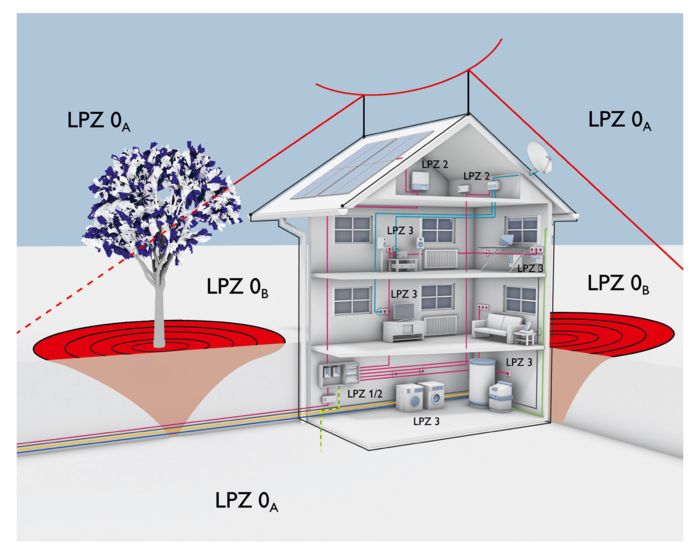
Protection against lightning - Part 1: General principles
Protection against lightning - Part 1: General principles
• IEC 62305-1
• EN 62305-1
• DIN EN 62305-1 (VDE 0185-305-1)
Protection against lightning - Part 2: Risk management
Protection against lightning - Part 2: Risk management
• IEC 62305-2
• EN 62305-2
• DIN EN 62305-2 (VDE 0185-305-2)
Protection against lightning - Part 2: Risk management - Supplement 1: Lightning threat in Germany
Protection against lightning - Part 2: Risk management - Supplement 1: Lightning threat in Germany
• DIN EN 62305-2 Supplement 1 (VDE 0185-305-2 Supplement 1)
Protection against lightning - Part 2: Risk management - Supplement 2: Calculation assistance for assessment of risk for structures, with CD-ROM
Protection against lightning - Part 2: Risk management - Supplement 2: Calculation assistance for assessment of risk for structures, with CD-ROM
• DIN EN 62305-2 Supplement 2 (VDE 0185-305-2 Supplement 2)
Protection against lightning - Part 2: Risk management; Supplement 3: Additional information for the application of DIN EN 62305-2 (VDE 0185-305-2)
Protection against lightning - Part 2: Risk management; Supplement 3: Additional information for the application of DIN EN 62305-2 (VDE 0185-305-2)
• DIN EN 62305-2 Supplement 3 (VDE 0185-305-2 Supplement 3)
Protection against lightning - Part 3: Physical damage to structures and life hazard
Protection against lightning - Part 3: Physical damage to structures and life hazard
• IEC 62305-3
• EN 62305-3
• DIN EN 62305-3 (VDE 0185-305-3)
Protection against lightning - Part 3: Physical damage to structures and life hazard - Supplement 1: Additional information for the application of DIN EN 62305-3
Protection against lightning - Part 3: Physical damage to structures and life hazard - Supplement 1: Additional information for the application of DIN EN 62305-3 (VDE 0185-305-3)
• DIN EN 62305-3 Supplement 1 (VDE 0185-305-3 Supplement 1)
Protection against lightning - Part 3: Physical damage to structures and life hazard - Supplement 2: Additional information for special structures
Protection against lightning - Part 3: Physical damage to structures and life hazard - Supplement 2: Additional information for special structures
• DIN EN 62305-3 Supplement 2 (VDE 0185-305-3 Supplement 2)
Protection against lightning - Part 3: Physical damage to structures and life hazard - Supplement 3: Additional information for the testing and maintenance of lightning protection systems
Protection against lightning - Part 3: Physical damage to structures and life hazard - Supplement 3: Additional information for the testing and maintenance of lightning protection systems
• DIN EN 62305-3 Supplement 3 (VDE 0185-305-3 Supplement 3)
Protection against lightning - Part 3: Physical damage to structures and life hazard - Supplement 4: Use of metallic roofs in lightning protection systems
Protection against lightning - Part 3: Physical damage to structures and life hazard - Supplement 4: Use of metallic roofs in lightning protection systems
• DIN EN 62305-3 Supplement 4 (VDE 0185-305-3 Supplement 4)
Protection against lightning - Part 3: Physical damage to structures and life hazard; Supplement 5: Lightning and overvoltage protection for photovoltaic power supply systems
Protection against lightning - Part 3: Physical damage to structures and life hazard; Supplement 5: Lightning and overvoltage protection for photovoltaic power supply systems
• DIN EN 62305-3 Supplement 5 (VDE 0185-305-3 Supplement 5)
Protection against lightning - Part 3: Physical damage to structures and life hazard; Supplement 6: Additional information on the requirement for lightning protection according to DIN EN 62305-3 (VDE 0185-305-3)
Protection against lightning - Part 3: Physical damage to structures and life hazard; Supplement 6: Additional information on the requirement for lightning protection according to DIN EN 62305-3 (VDE 0185-305-3)
• DIN EN 62305-3 Supplement 6 (VDE 0185-305-3 Supplement 6)
Protection against lightning - Part 4: Electrical and electronic systems within structures
Protection against lightning - Part 4: Electrical and electronic systems within structures
• IEC 62305-4
• EN 62305-4
• DIN EN 62305-4 (VDE 0185-305-4)
Protection against lightning - Part 4: Electrical and electronic systems within structures - Supplement 1: Sharing of the lightning current
Protection against lightning - Part 4: Electrical and electronic systems within structures - Supplement 1: Sharing of the lightning current
• DIN EN 62305-4 Supplement 1, VDE 0185-305-4 Supplement 1



















